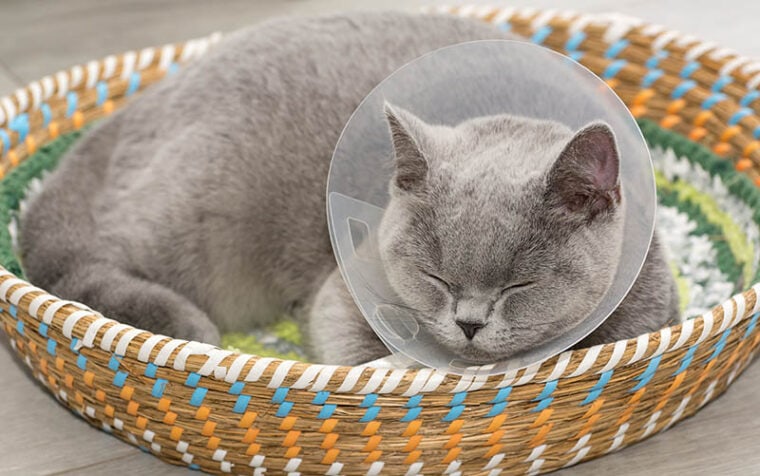
No pet is a fan of the “cone of shame,” but cats can become contortionists trying to remove an e-collar. Of course, you want to follow your vet’s instructions and keep your cat safe after surgery or other medical procedure, but does it have to be such a hassle? Here are seven great alternatives to traditional e-collars that may work better for cats.
The 7 Great Alternatives to E-collars for Cats
1. Soft E-collar
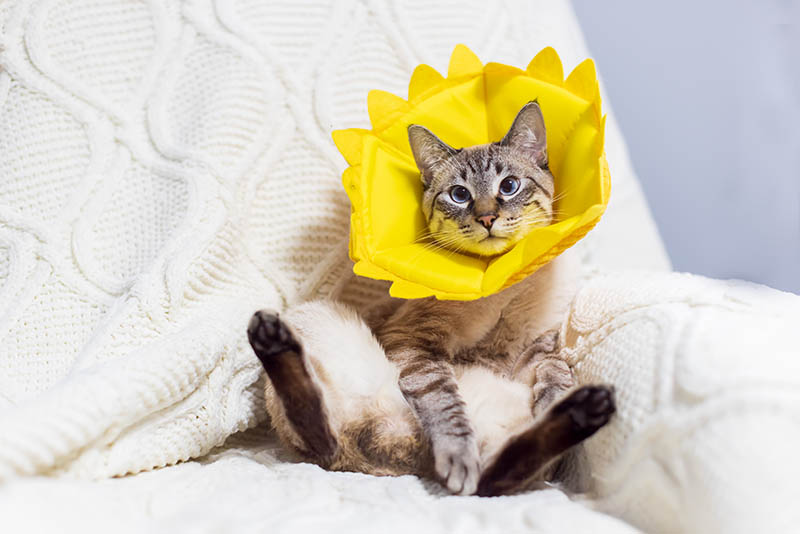
Traditional plastic e-collars are stiff and heavy, making it hard for a cat to perform basic functions like eating, drinking, and snoozing. One alternative is to use an e-collar made of a softer material. Your vet may carry a version made of a flexible, waxed paper product.
You can also look for cloth collars or padded ones that use Velcro to stay in place. These collars tend to be lighter and more comfortable than traditional plastic cones and can still serve to keep your cat from disturbing an incision or wound.
2. Inflatable E-collar

This e-collar is usually made of material similar to an inner tube or swim floaties, with a soft, padded interior. Once inflated, they can attach with ties or Velcro. Inflatable e-collars don’t extend past the cat’s nose but instead rely on their bulk to make it hard for the cat to turn their head to lick at an incision or wound.
Because of this, they won’t work for every scenario. In addition, there’s always the chance your cat will puncture the collar, trying to scratch it off, but they’re made from pretty tough material.
3. Pillow E-collar
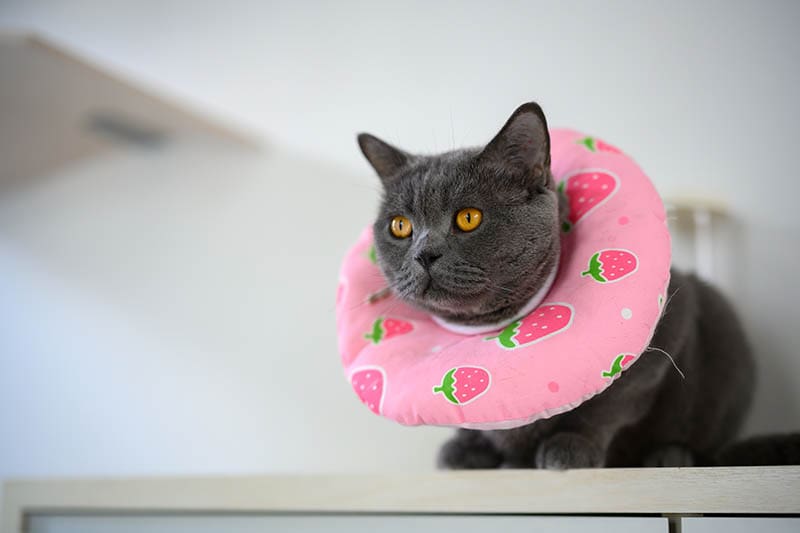
Pillow e-collars work in a similar fashion to inflatable e-collars but are made like a neck pillow you would use to sleep on a plane. They attach around the cat’s neck and, in theory, block them from bending their head around to reach the area of concern.
Because they don’t extend past your cat’s nose, the pillow e-collar shouldn’t keep your cat from being able to eat and drink normally. However, your cat may have trouble finding a comfortable sleeping position with this collar. In addition, it probably won’t keep your kitty from reaching a paw, tail, or even leg if that’s what you’re trying to avoid.
4. Body Suit
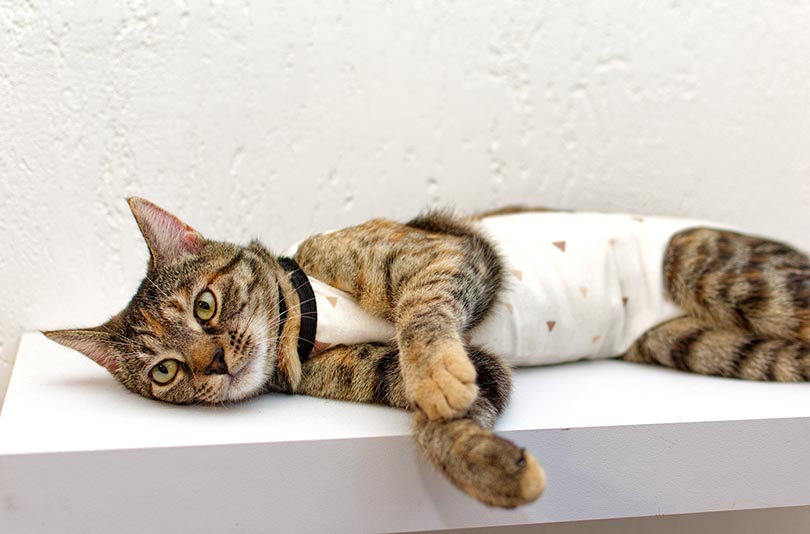
For something completely different, skip the e-collar in favor of dressing your cat in a form-fitting body suit to keep its incision or wound covered. You can generally purchase these suits ready-made in various sizes, colors, and patterns.
If you’re handy with a sewing machine, you could even make your own custom suit for your cat. This option generally works best for wounds or incisions on the cat’s belly, such as from spay surgery. Legs and tails won’t be protected. If your cat dislikes wearing clothing, they may not tolerate a body suit any more than an e-collar.
5. Baby Clothing
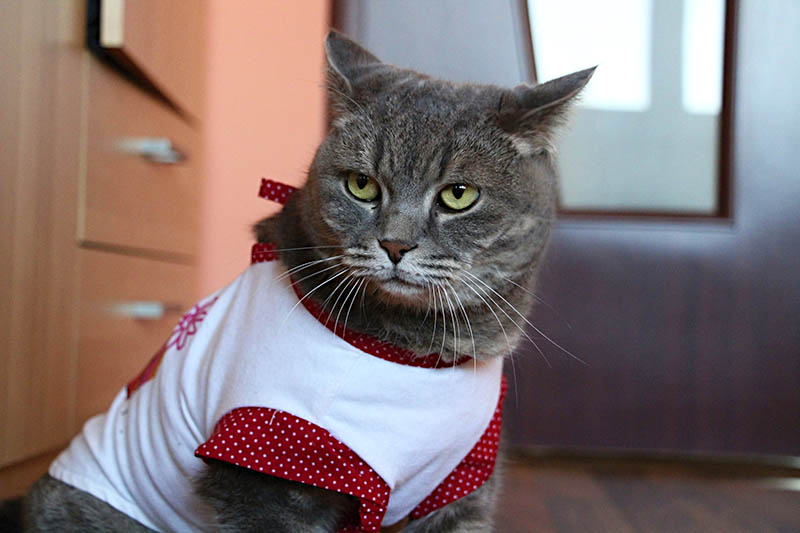
Many pet owners think of their cats as “fur babies,” but you can take advantage of the fact that many kitties are the same size as human babies for this e-collar alternative. Baby clothing is an inexpensive, easy-to-find way to keep belly and body incisions covered and safe.
Because they’re meant to snap around the baby’s body, they can also stay secured around your cat. You’ll need to make some alterations to allow your cat’s tail to fit through and avoid blocking any necessary bodily functions. For this alternative to work, your cat must tolerate wearing clothing. You’ll also need to keep a close eye on the garment to ensure your cat doesn’t get pee or poop on it.
6. Small T-shirt

Another alternative to traditional e-collars is to dress your cat in a tiny baby or toddler T-shirt. You can secure it around your cat’s waist with a knot or hairband. Because they don’t cover your cat’s rear, keeping a T-shirt clean is easier than a baby onesie.
The shirts are also cheap and easy to buy at any secondhand shop or thrift store. You can get creative with colors and patterns or support your favorite sports team! T-shirts fit more loosely than other clothing alternatives, and your cat could easily push it up to reach an incision if they’re motivated.
7. Dog or Cat Sweater

Another option is to fit your cat with a small dog sweater or one made just for kitties. The advantage of clothing designed for pets is that they should fit more snugly than T-shirts while leaving your cat’s tail and rear free, unlike baby onesies.
Like most clothing, this alternative works best for belly or body incisions. Pet sweaters tend to be shorter on the belly side, so they may not provide full coverage depending on where the incision is located. They’re also ineffective for wounds in other locations, especially on your cat’s limbs, tail, or rear end.
Tips to Help Your Cat Tolerate a Traditional E-collar
In some cases, you may have no choice but to place your cat in the cone of shame. Maybe your cat isn’t tolerating any of these alternatives or is still able to reach its incision while wearing them. Some medical conditions, like eye injuries, usually can’t be managed safely without a traditional e-collar.
Often, your cat has already been wearing an e-collar in the vet hospital before coming home. In these circumstances, they may already have gotten used to wearing it. If so, don’t make things complicated by taking the collar off at home because you feel sorry for your cat. Instead, offer them some treats to help build positive associations.
If your cat starts to fixate on removing the collar, try distracting them with toys or a dish of their favorite food. Most e-collars are wide enough to allow your cat access to food and water, even if a dramatic kitty tries to act otherwise! You could try elevating their dishes temporarily or holding the bowl for them to eat more easily.
You’ll usually get mixed opinions from vets on whether it’s okay to take your cat’s e-collar off temporarily with close supervision. Many recommend against it because it can be hard to get the e-collar back in the proper position, and too many owners don’t actually watch their cats closely enough with it off.
Others will say it’s acceptable for short periods while the cat is sitting in your lap under direct supervision or eating and drinking with you right there. Cats can chew stitches out faster than you might think, so even a momentary distraction on your part can be trouble.
Conclusion
Some cats tolerate traditional e-collars without complaints, while others behave as if the world is ending and it is all their fault. Every vet and vet tech can tell you horror stories of preventable infections and injuries that occurred when a cat owner felt sorry for their cat and didn’t make them wear the e-collar as instructed. These seven alternatives may work for your cat, but always check with your vet before trying them, and be prepared to go back to the cone if they aren’t effective.
Featured Image Credit: Lilia Solonari, Shutterstock








